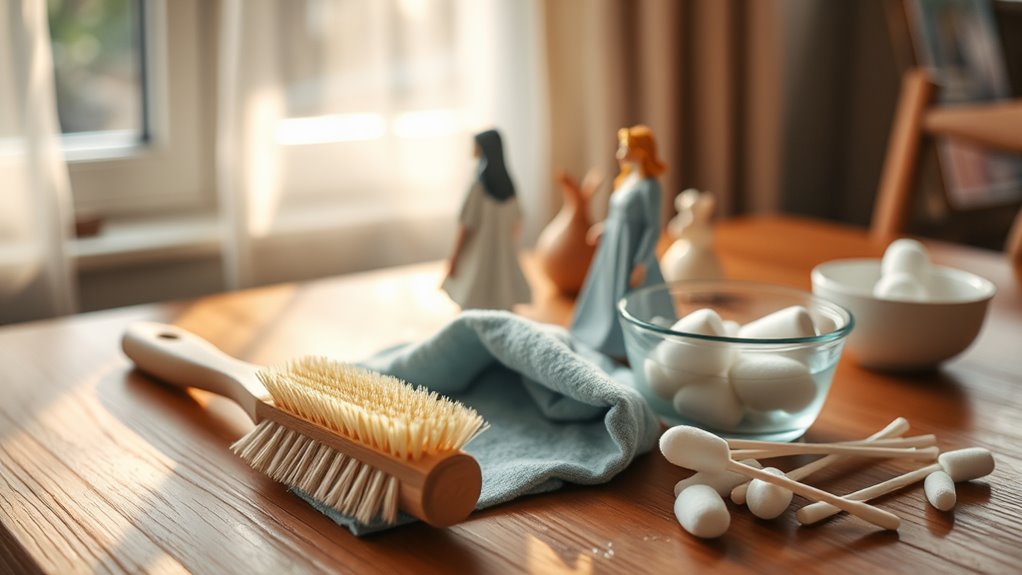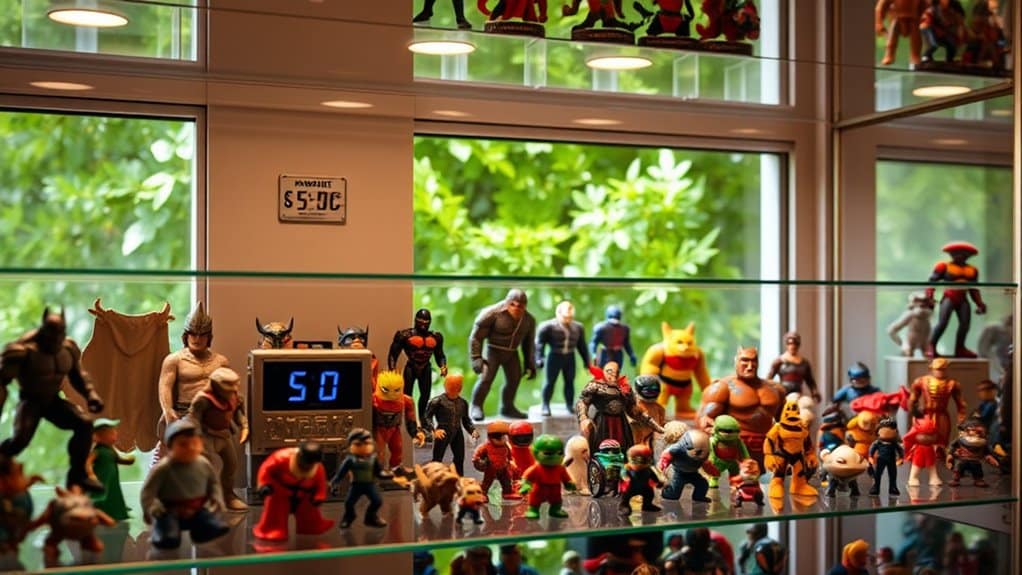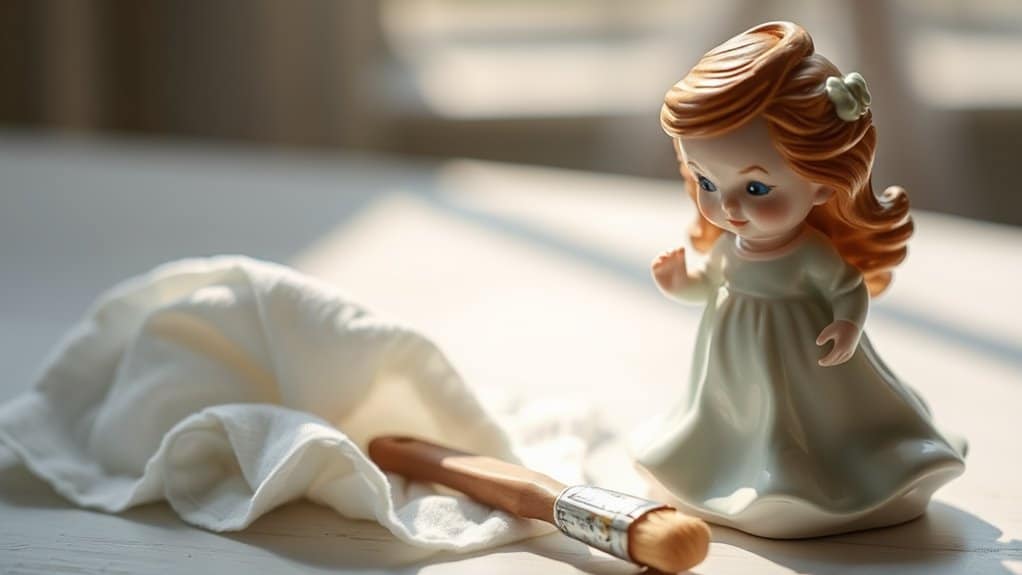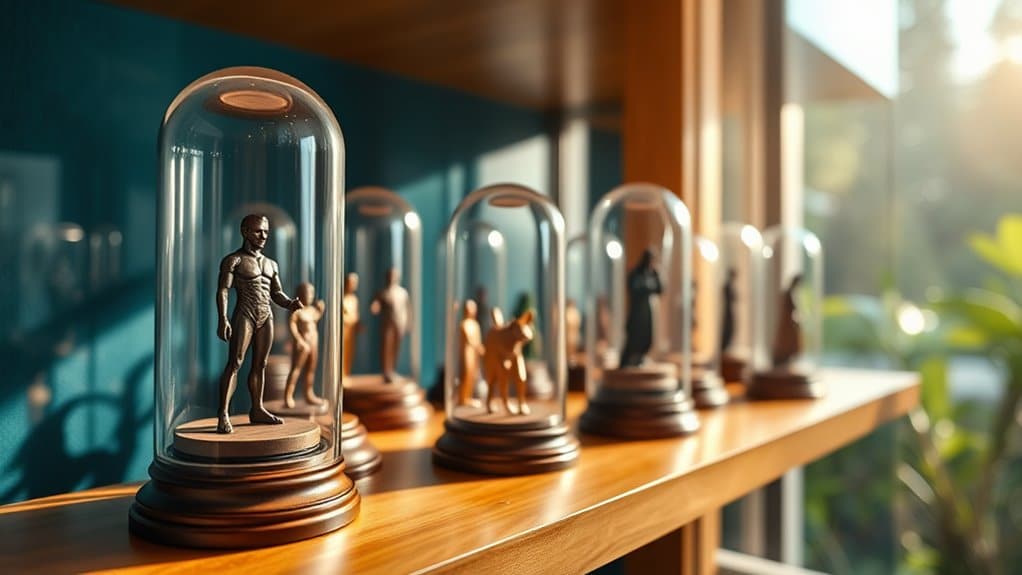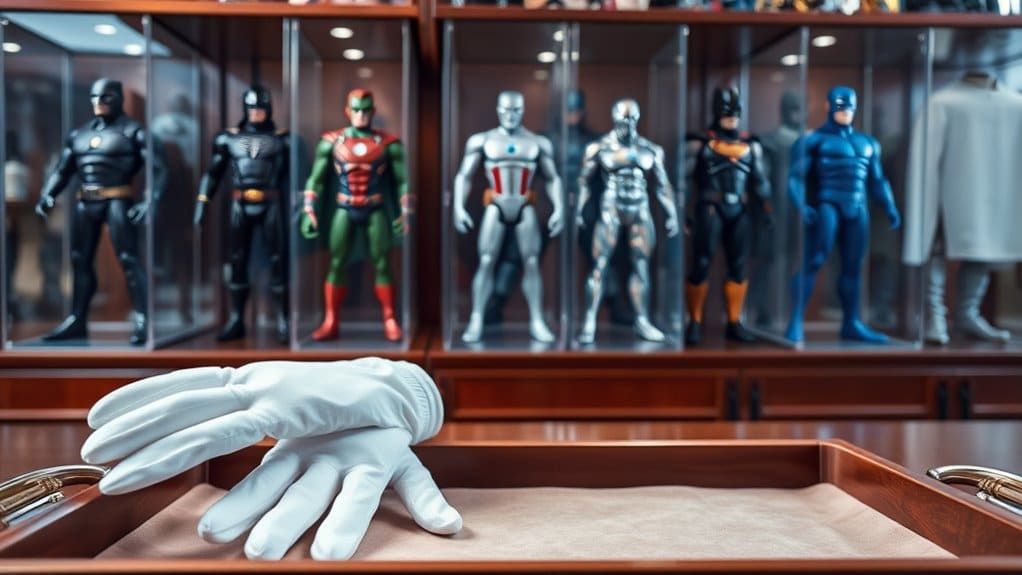To clean figurine paint effectively, stick to gentle methods and tools. Start with a soft, lint-free cloth or microfiber for dusting. Use a soft brush for detailed spots, focusing on tight areas. For cleaning, mild soap and water, or a vinegar-water solution, work wonders. Avoid harsh chemicals to keep colors vibrant. Meanwhile, dab gently and air-dry in a ventilated space. Interested in exploring more cleaning techniques to protect your collectibles even further?
Gentle Dusting Techniques
When it comes to keeping your figurines pristine, gentle dusting techniques are essential. Start by selecting a soft, lint-free cloth to avoid scratching the paint. You'll want to hold the figurine securely and gently wipe away dust, focusing on flat surfaces. For those tricky spots, use a gentle puff of air from a can of compressed air to dislodge dust without touching the figurine. Always make certain you're holding the can upright to prevent moisture from escaping.
Avoid using paper towels or rough fabrics, as they can damage the paint. Regularly dusting your figurines prevents buildup, maintaining their vibrant colors and intricate details. By incorporating these simple steps into your routine, you'll make certain your collection remains in top condition for years to come.
Using Soft Brushes for Detailing
Although gentle dusting is effective for surface cleaning, using soft brushes for detailing guarantees every nook and cranny of your figurines is spotless. You'll find soft-bristled brushes are perfect for reaching intricate areas that might be missed otherwise. Choose a brush with natural or synthetic bristles that won't scratch the paint. A fine-tipped brush can help you get into those tight spots, like folds in clothing or detailed facial features.
Hold your figurine securely, and gently brush away any dust or dirt using light, sweeping motions. Avoid applying too much pressure to prevent damaging delicate parts. Regularly clean your brush to make certain you're not spreading dust around. With patience and a gentle touch, your figurines will look their best, showcasing every exquisite detail.
Microfiber Cloths for Surface Cleaning
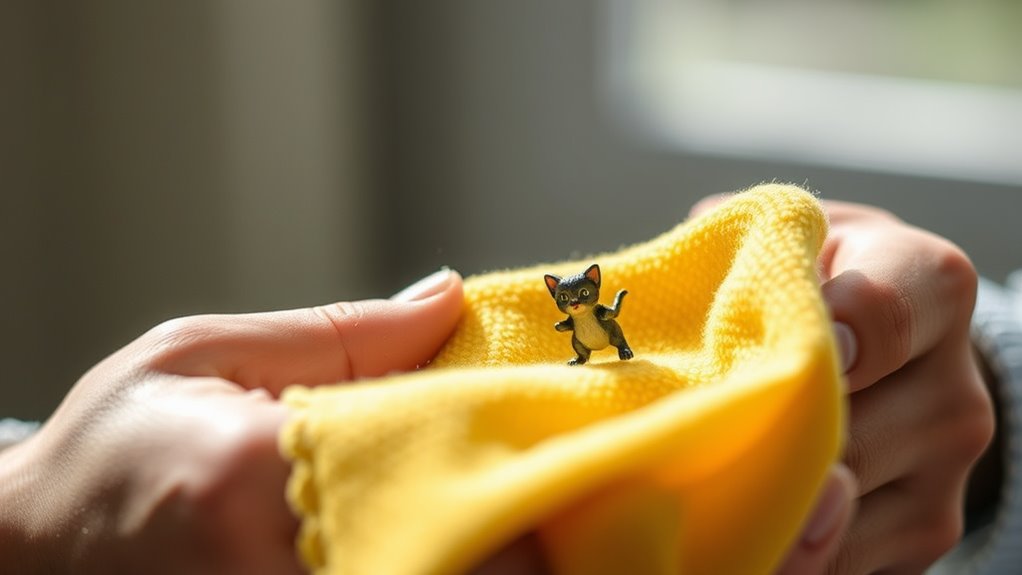
Microfiber cloths are a fantastic tool for surface cleaning your figurines. They're gentle yet effective, ensuring you remove dust without scratching or damaging paint. When you use a microfiber cloth, its tiny fibers trap dirt and debris, leaving your figurine spotless. Always start with a dry cloth to gently wipe away loose particles.
For intricate areas, fold the cloth to create a precise edge or corner. This allows you to reach into grooves and between delicate parts. Avoid using too much pressure; let the cloth do the work. It's important to keep your microfiber cloth clean, as trapped dirt can scratch surfaces. Wash it regularly, but avoid fabric softeners that might reduce its effectiveness. With microfiber, your figurines will look pristine and well-maintained.
Safe Soap and Water Solutions
To safely clean your figurines, a mild soap and water solution can be incredibly effective. Start by filling a small basin with lukewarm water. Add a few drops of a gentle dish soap, stirring to create a light lather. Avoid harsh chemicals that might damage the paint. Dip a soft cloth or sponge into the soapy water, and gently wipe your figurine's surface. Be careful not to scrub too hard, as this could affect the paint's finish. Pay attention to crevices where dust and grime often hide. After cleaning, rinse your figurine with clean water to remove any soap residue. Pat it dry with a soft towel, and let it air dry completely before placing it back on display.
Vinegar and Water Mixture

To effectively clean figurine paint, try mixing one part vinegar with two parts water for a gentle yet effective solution. Apply this mixture with a soft cloth or brush, ensuring you work in small sections to avoid over-saturation. Remember to wear gloves and work in a well-ventilated area to keep things safe and comfortable.
Mixing Ratios and Tips
When it comes to cleaning figurine paint, achieving the right vinegar and water mixture is crucial for preserving the delicate surface. Start with a ratio of one part vinegar to three parts water. This balance is gentle enough to remove grime without harming the paint. Always use distilled white vinegar to avoid any unwanted residues.
To guarantee success, keep these tips in mind:
- Test a small area first: Dab a bit of the solution on an inconspicuous part of the figurine. Wait a few minutes to check for any adverse reactions.
- Use a soft cloth: Opt for a microfiber cloth that won't scratch or damage the surface while cleaning.
- Avoid over-saturation: Excessive liquid can seep into crevices. Lightly dampen your cloth for best results.
Application Techniques
With your vinegar and water mixture ready, it's time to focus on how to apply it effectively for cleaning figurine paint. Start by dipping a soft, lint-free cloth or a cotton swab into the mixture. Gently dab the solution onto a small, inconspicuous area of the figurine to test for any adverse reactions. Once you're confident it's safe, proceed by lightly wiping the painted surfaces. Avoid excessive pressure to prevent paint removal or damage. For intricate areas, use a soft-bristled toothbrush to reach crevices without scratching. Always work in small sections, ensuring the mixture doesn't pool or drip. Once done, immediately wipe the figurine with a clean, damp cloth to remove any vinegar residue, then dry thoroughly with a soft towel.
Safety Precautions
Why is it vital to prioritize safety when using a vinegar and water mixture for cleaning figurine paint? Safeguarding your safety while cleaning is essential to prevent any accidental damage to yourself or the figurines. Vinegar is acidic, and though diluted, it can still cause irritation if mishandled. Here are a few precautions to take into account:
- Wear gloves: Protect your skin from potential irritation. Gloves act as a barrier between your hands and the cleaning solution.
- Guarantee proper ventilation: Open windows or use fans to disperse any strong odors, preventing them from becoming overwhelming.
- Test a small area first: Apply the mixture to a less visible section of the figurine to verify it doesn't harm the paint.
The Magic of Baking Soda Paste
Although it might seem like a simple pantry ingredient, baking soda can work wonders when it comes to cleaning figurine paint. Start by mixing equal parts of baking soda and water to form a paste. This gentle yet effective solution helps remove dirt and grime without damaging the paint. Apply the paste to a soft cloth or brush and gently rub it over the affected areas of your figurine. Focus on spots with visible stains or discoloration. The baking soda's mild abrasiveness lifts the grime, while its natural deodorizing properties leave your figurine looking fresh. Once finished, rinse the figurine with water and pat it dry with a clean cloth. You'll be amazed at how this simple technique revives your beloved pieces.
Rubbing Alcohol for Tough Stains
When you encounter stubborn stains that refuse to budge, rubbing alcohol can be your go-to solution. It's a powerful agent that dissolves grime without damaging the paint. Apply a small amount on a cotton swab, then gently rub the stained area. You'll be amazed at how quickly it lifts away the residue, restoring your figurine's original charm.
Here's what you'll need to create an effective cleaning session:
- Cotton swabs: To target precise areas without affecting the surrounding paint.
- Rubbing alcohol: A small bottle is enough to last through multiple cleaning sessions.
- Soft cloth: For buffing and drying the cleaned surface, ensuring no streaks are left behind.
Commercial Figurine Cleaning Products
If rubbing alcohol isn't your preferred method or you want a more specialized approach, commercial figurine cleaning products might be the answer. These products are specifically designed to tackle dirt and grime on delicate surfaces without harming the paint. Start by checking the instructions on the label to guarantee you're using them correctly. Apply a small amount to a soft cloth or cotton swab and gently wipe the figurine, focusing on areas with visible residue.
When choosing a product, look for ones that emphasize gentle, non-abrasive ingredients. Many hobby stores offer cleaners specifically tailored for various materials like resin, porcelain, or metal. These commercial solutions can effectively preserve the original finish while maintaining your figurine's vibrant colors. They're a reliable option for collectors wanting to protect their treasures.
Avoiding Harsh Chemicals
When cleaning figurine paint, it's best to steer clear of harsh chemicals that might damage your collectibles. You can opt for natural cleaning solutions like vinegar or baking soda, which are both effective and safe. By using gentle cleaning techniques, you'll preserve the quality and longevity of your figurines without risking unnecessary harm.
Natural Cleaning Solutions
Caring for your cherished figurines doesn't have to involve harsh chemicals; instead, consider using natural cleaning solutions. These gentle alternatives not only protect your figurines but also guarantee a safer environment for you. Vinegar, for instance, is a powerful natural cleaner. Mix it with water for a simple solution that can tackle grime effectively. Baking soda is another fantastic option. Its mild abrasiveness makes it perfect for removing stubborn dirt without scratching the paint. Lemon juice, with its natural acidity, can help brighten and refresh your figurines.
Imagine using:
- Vinegar and water: a potent duo that cleans and disinfects.
- Baking soda paste: gently scrubs away dirt.
- Lemon juice: naturally lifts stains and adds shine.
Embrace these natural solutions for clean, vibrant figurines.
Gentle Cleaning Techniques
Natural cleaning solutions provide a great foundation, but how you apply them matters just as much. To preserve your figurine's paint, opt for a soft microfiber cloth. Gently dab, don't scrub, as aggressive movements can damage delicate surfaces. Use a cotton swab for hard-to-reach areas, lightly moistening it with your chosen cleaner. Always test the cleaner on an inconspicuous spot first to verify no adverse reactions.
Avoid soaking the figurine, as excess moisture can seep into crevices, causing damage. Instead, apply the solution sparingly and wipe off any residue immediately. If the paint is particularly fragile, consider using a soft-bristled brush to softly dust away dirt. Patience and gentle handling are key to maintaining the integrity of your cherished piece.
Proper Drying Methods
Although careful cleaning is essential, proper drying methods guarantee your figurine paint remains pristine. First, gently pat the figurine with a soft, lint-free cloth to remove excess moisture. Avoid rubbing as it can disturb the paint. Position your figurine in a well-ventilated area, allowing air circulation to naturally dry the surface. Don't rush; patience here preserves your figurine's vibrant colors and intricate details.
Consider these important tips:
- Natural Light: Place it near a window, but avoid direct sunlight to prevent fading.
- Heightened Airflow: Use a fan set on low to enhance drying, ensuring it's not too close.
- Dehumidifier: In humid environments, a dehumidifier helps maintain ideal conditions.
Frequently Asked Questions
How Do I Store Figurines to Prevent Dust Build-Up?
Store figurines in enclosed glass cabinets to prevent dust build-up. Use airtight containers for long-term storage. Keep them away from direct sunlight and humidity. Regularly clean the display space to guarantee minimal exposure to dust.
Can I Use Essential Oils for Cleaning Figurines?
You shouldn't use essential oils for cleaning figurines as they can leave a residue and damage paint. Instead, use a soft microfiber cloth and a mild soap solution to gently clean without harming your figurine's finish.
What Temperature Is Ideal for Washing Figurines?
You'd think washing figurines at the wrong temperature would cause them to melt like ice cream on a hot day! Use lukewarm water. It's gentle enough to avoid damage while effectively removing dirt and grime.
Are There Any Natural Alternatives to Commercial Cleaning Products?
You can use natural alternatives like vinegar and baking soda to clean surfaces. Mix them into a paste and apply gently. They'll remove grime without harsh chemicals, keeping your items safe and the environment happy.
How Often Should Figurines Be Cleaned to Maintain Their Paint Quality?
To keep your figurines looking spiffy, clean them every few months. Dust them gently with a soft brush or cloth. Avoid over-cleaning to prevent paint damage. Remember, a little maintenance goes a long way, like tending a Victory Garden.
At a Glance
When cleaning figurines, remember that "an ounce of prevention is worth a pound of cure." Start with gentle dusting and detailing using soft brushes and microfiber cloths to maintain their charm. For stubborn stains, opt for safe soap solutions or a vinegar mixture, and use rubbing alcohol sparingly. Always steer clear of harsh chemicals and guarantee proper drying to protect your treasures. With these steps, your figurines will always look their best.

